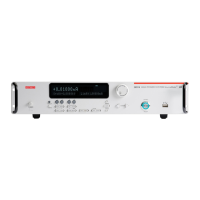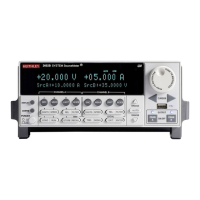3-8
SECTION 3
Bipolar Transistor Tests
may be necessary to increase the number of iterations if the target
range is reduced.
3.5.8 Configuration for Fast
Current Gain Tests
Figure 3-6 shows the test configuration for an alternate method
of current gain tests—one that is much faster than the search
method discussed previously. SMUB is used to supply V
CE
, and
it also measures I
B
. SMUA sources the emitter current (I
E
) rather
than the collector current (I
C
). Because we are sourcing emitter
current instead of collector current, the current gain calculations
must be modified as follows:
I
E
– I
B
ß =
_____
I
B
WARNING
When a System SourceMeter instrument is pro-
grammed for remote sensing, hazardous voltage
may be present on the SENSE and OUTPUT termi-
nals when the unit is in operation regardless of the
programmed voltage or current. To avoid a possible
shock hazard, always turn off all power before
connecting or disconnecting cables to the Source-
Measure Unit or the associated test fixture.
NOTE
Because of the connection convention used, I
E
and
V
CE
must be programmed for opposite polarity than
normal. With an NPN transistor, for example, both V
CE
and I
E
must be negative.
3.5.9 Example Program 6B: DC Current
Gain Using Fast Method
Use Program 6B in Appendix A to demonstrate the fast method of
measuring current gain of bipolar transistors. Proceed as follows:
With the power off, connect a dual-channel System Source-1.
Meter instrument to the computer’s IEEE-488 interface.
Connect the test fixture to both units using appropriate cables. 2.
Note that OUTPUT HI of SMUB is connected to the base of the
DUT, and SENSE HI of SMUB is connected to the emitter.
Turn on the System SourceMeter instrument and allow the 3.
unit to warm up for two hours for rated accuracy.
Turn on the computer and start Test Script Builder (TSB). Once 4.
the program has started, open a session by connecting to the
instrument. For details on how to use TSB, see the Series 2600
Reference Manual.
You can simply copy and paste the code from Appendix A in 5.
this guide into the TSB script editing window (Program 6B),
manually enter the code from the appendix, or import the TSP
file ‘DC_Gain_Fast.tsp’ after downloading it to your PC.
If your computer is currently connected to the Internet, you
can click on this link to begin downloading: http://www.
keithley.com/data?asset=50926
Install an NPN transistor such as a 2N5089 in the appropriate 6.
transistor socket of the test fixture.
Now, we must send the code to the instrument. The simplest 7.
method is to right-click in the open script window of TSB,
and select ‘Run as TSP file’. This will compile the code and
place it in the volatile run-time memory of the instrument.

